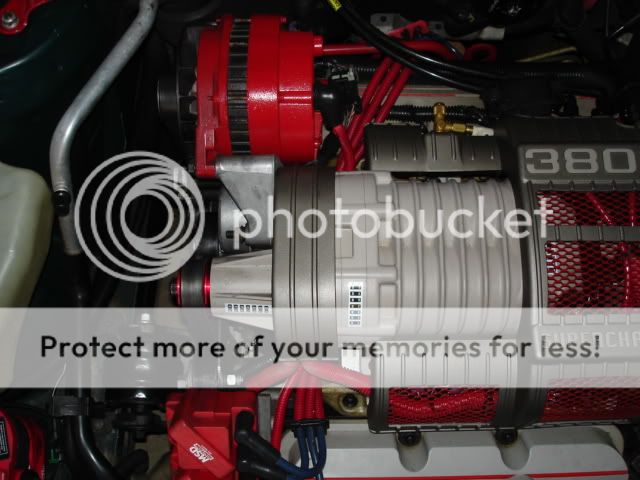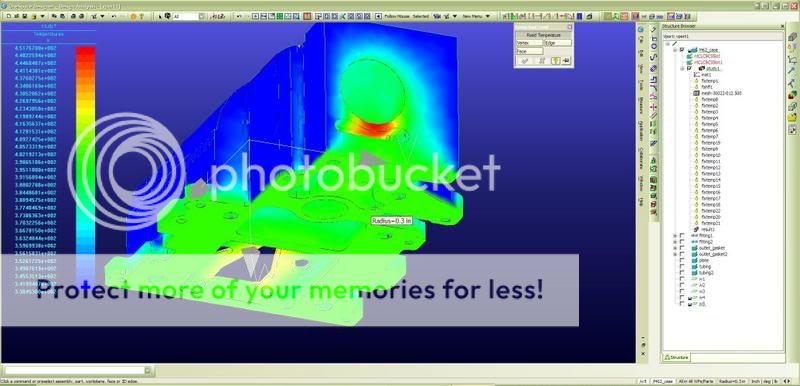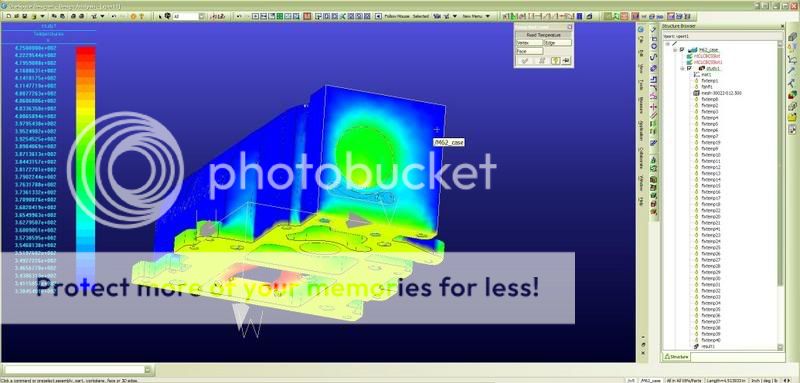cooling tb
#1
Member
Posts like a V-Tak
Thread Starter
Join Date: Sep 2006
Location: Lavaltrie,quebec, canada
Posts: 61
Likes: 0
Received 0 Likes
on
0 Posts

Is it a good idea,for hot summer time ,put a transmission cooler installed before the prestone passage in the tb to lower the temperature of the prestone just before the tb...do you understand what I want to explain with my very good english,a little rad in front of the car before the inlet of tb on a l-67????for cooling the prestone..
#2
The best thing to do to cool the tb is to block the coolant passages off in the lower intake manifold and run a 160 stat.............for the summer only.
If you really want cool, spray some Nitrous in there.
If you really want cool, spray some Nitrous in there.

#3
Member
Posts like a V-Tak
Thread Starter
Join Date: Sep 2006
Location: Lavaltrie,quebec, canada
Posts: 61
Likes: 0
Received 0 Likes
on
0 Posts

I' m hesiting to block it on a L-67 in the summer time when the temperature is hot ,it' * a cooling effect in tb,on a L-36 we can, but I ' m affraid to make that on a L-67
#4
Junior Member
Posts like a Ricer Type-R
Your SSEi will not run properly on a 160 Stat. I had to make major changes to mine to make that work.
In addition, that TB coolant is your FRIEND when you heatsoak the car in the summer. It will actually cool your TB on hot days. I've done hours of testing on this.
For this reason, mine are not blocked. Besides, most of your 'heating' of the incoming charge of air doesn't happen in the TB. How much time does the air even spend in contact with the TB? Not much. And it doesn't run anywhere NEAR the temps of the SC'* inlet.
In addition, that TB coolant is your FRIEND when you heatsoak the car in the summer. It will actually cool your TB on hot days. I've done hours of testing on this.
For this reason, mine are not blocked. Besides, most of your 'heating' of the incoming charge of air doesn't happen in the TB. How much time does the air even spend in contact with the TB? Not much. And it doesn't run anywhere NEAR the temps of the SC'* inlet.
Originally Posted by willwren
Let'* start with a simplified model. This is an M62 (really no different for the
purposes of the debate than an M90) under normal operating (street) conditions.
We'll ignore the track conditions for now, but we'll come back to it:

What'* the hottest surface? The INLET. Not the outlet. Why? Restriction/friction
of airflow. To be honest, this is a very simple model. It doesn't have the cooling
ports, and some of the conditions may be based on theory, rather than reality. So
we take this data as a starting point, and try to refine the model (this analysis was
done by a group of college engineering students at least 3 or 4 years ago.
Fast forward to the current state of the Zilla:

See the little temperature strips? There are 9 of them on the SC, Nosedrive, TB,
and LIM. Why? I wanted to know not only WHAT temperatures were typical in
different driving conditions, but also HOW it heats up. What'* hot first? Where
does the heat start, and how does the SC react during heatsoak? Does the
coolant actually HELP?
So then I made a model.

That was a long time ago, and for another purpose as well, but a good 3D model is
the starting point for a good thermal analysis job.
So I took everything I learned from the original thermal analysis (top image in this topic),
and everything I learned from REAL data from my own car (coolant temps, stuck-on
thermal temp strips, and IR heat analysis) in multiple conditions. Different ambient air
temps, wet weather, dry weather, street conditions, long trips, and track.
Now let'* apply all THAT to the 3D model WITHOUT coolant flow (temps are typical on
a warmed up engine after about 15 minutes of driving in ambient 60°F air, 200° LIM):

The dark blue is constrained to 150°F (338Kelvin) to represent engine bay ambient
temps, and the bottom surface is constrained to typical LIM temps. As you can see,
the BOTTOM of the inlet is the hottest surface. This is what pre-heats your incoming
air for you. Nice, huh?
Now let'* induce some coolant flow and kick up the incoming air temp a bit to REALLY
see what'* going on (85° ambient air, 180° coolant temp in the SC coolant ports, 250°F
LIM temp):

See the positive result in the inlet despite the increased IAT and LIM temps?
Coolant flow controls it.
Now to be honest, there are other factors at work here, but I think I've captured the
critical data very well in these models. On a track, with sufficient cooling, you'll be OK.
SC temps don't spike at the track until AFTER the run. But if you drive your car daily,
you need the coolant. And you can STILL cool down between runs at the track. You've
lost nothing.
Ideal solution? A seperately cooled interface plate between the SC and LIM, that routes
coolant (not engine coolant) through the plate beneath the SC, and through the SC to the
TB. Something like this:

Further incoming air temp improvements are the direct result of polishing your SC inlet.
As a point of comparison:
My Gen3 M62 inlet and TB run 15° cooler than Matt'* Gen3 M90, despite the fact that
I was moving far more air with a 2.0" pulley than his stock 3.8" pulley. This is a direct
result of polishing the rough inlet surface left over from the casting process.
This was after an extended high-throttle side-by-side run in 106°F ambient conditions.
I hope I've answered the question from this topic, at least with regards to the L67'* out
there. The data is going to come out differently for L27'* and L36'*, as the inlets won't
be as hot to begin with. But it'* something to chew on.
Long and short of it based on what I've learned on my own car and through thermal
analysis:
Normal driving conditions require the coolant to manage SC inlet temperatures
Furthermore, blocking the coolant ports is no advantage at the track if you're cooling
in the staging lanes between runs and icing the SC housing.
purposes of the debate than an M90) under normal operating (street) conditions.
We'll ignore the track conditions for now, but we'll come back to it:

What'* the hottest surface? The INLET. Not the outlet. Why? Restriction/friction
of airflow. To be honest, this is a very simple model. It doesn't have the cooling
ports, and some of the conditions may be based on theory, rather than reality. So
we take this data as a starting point, and try to refine the model (this analysis was
done by a group of college engineering students at least 3 or 4 years ago.
Fast forward to the current state of the Zilla:

See the little temperature strips? There are 9 of them on the SC, Nosedrive, TB,
and LIM. Why? I wanted to know not only WHAT temperatures were typical in
different driving conditions, but also HOW it heats up. What'* hot first? Where
does the heat start, and how does the SC react during heatsoak? Does the
coolant actually HELP?
So then I made a model.

That was a long time ago, and for another purpose as well, but a good 3D model is
the starting point for a good thermal analysis job.
So I took everything I learned from the original thermal analysis (top image in this topic),
and everything I learned from REAL data from my own car (coolant temps, stuck-on
thermal temp strips, and IR heat analysis) in multiple conditions. Different ambient air
temps, wet weather, dry weather, street conditions, long trips, and track.
Now let'* apply all THAT to the 3D model WITHOUT coolant flow (temps are typical on
a warmed up engine after about 15 minutes of driving in ambient 60°F air, 200° LIM):

The dark blue is constrained to 150°F (338Kelvin) to represent engine bay ambient
temps, and the bottom surface is constrained to typical LIM temps. As you can see,
the BOTTOM of the inlet is the hottest surface. This is what pre-heats your incoming
air for you. Nice, huh?
Now let'* induce some coolant flow and kick up the incoming air temp a bit to REALLY
see what'* going on (85° ambient air, 180° coolant temp in the SC coolant ports, 250°F
LIM temp):

See the positive result in the inlet despite the increased IAT and LIM temps?
Coolant flow controls it.
Now to be honest, there are other factors at work here, but I think I've captured the
critical data very well in these models. On a track, with sufficient cooling, you'll be OK.
SC temps don't spike at the track until AFTER the run. But if you drive your car daily,
you need the coolant. And you can STILL cool down between runs at the track. You've
lost nothing.
Ideal solution? A seperately cooled interface plate between the SC and LIM, that routes
coolant (not engine coolant) through the plate beneath the SC, and through the SC to the
TB. Something like this:
Further incoming air temp improvements are the direct result of polishing your SC inlet.
As a point of comparison:
My Gen3 M62 inlet and TB run 15° cooler than Matt'* Gen3 M90, despite the fact that
I was moving far more air with a 2.0" pulley than his stock 3.8" pulley. This is a direct
result of polishing the rough inlet surface left over from the casting process.
This was after an extended high-throttle side-by-side run in 106°F ambient conditions.
I hope I've answered the question from this topic, at least with regards to the L67'* out
there. The data is going to come out differently for L27'* and L36'*, as the inlets won't
be as hot to begin with. But it'* something to chew on.
Long and short of it based on what I've learned on my own car and through thermal
analysis:
Normal driving conditions require the coolant to manage SC inlet temperatures
Furthermore, blocking the coolant ports is no advantage at the track if you're cooling
in the staging lanes between runs and icing the SC housing.
#6
Junior Member
Posts like a Ricer Type-R
My testing so far (keep in mind this is on one of my cars, results may differ with different engines/setups/mods), I've found the best possible solution would be to leave it open for daily use, and plug it for the track where you have the chance to ice down between runs.
There isn't really a practical way to do that. This is one of the reasons I still have an external duct cooling my TB and SC inlet from a scoop underneath, but it'* only effective above 30mph.
http://www.bonnevilleclub.com/forum/...ht=iat+ambient
And it'* why I've also been testing a new coating for the SC that is known to reduce heat (accellerate cooling). Harofreak00 will also be testing the same coating on a TB soon.
This is also why I installed hood vents. There are other ways to control heatsoak, or at least slow it down or shorten the recovery time from it. Creativity is the key.
There isn't really a practical way to do that. This is one of the reasons I still have an external duct cooling my TB and SC inlet from a scoop underneath, but it'* only effective above 30mph.
http://www.bonnevilleclub.com/forum/...ht=iat+ambient
And it'* why I've also been testing a new coating for the SC that is known to reduce heat (accellerate cooling). Harofreak00 will also be testing the same coating on a TB soon.
This is also why I installed hood vents. There are other ways to control heatsoak, or at least slow it down or shorten the recovery time from it. Creativity is the key.
Thread
Thread Starter
Forum
Replies
Last Post
zzzzzeke
Performance, Brainstorming & Tuning
8
03-10-2003 12:33 PM


